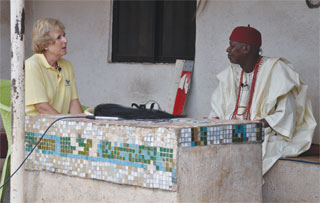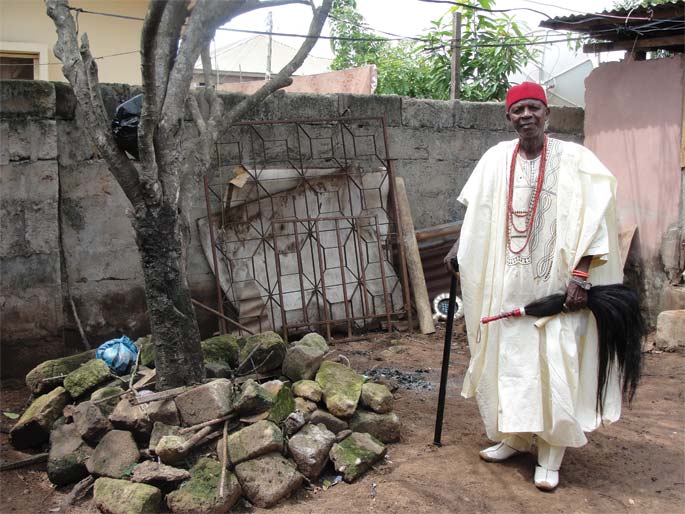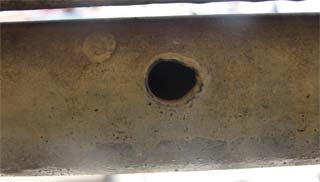Feature
Report From Asaba
October 1967. In Nigeria, on the west coast of Africa, civil war raged. Ethnic and cultural differences fueled the fighting, which followed the secession of the mostly Igbo region to the east of the Niger River, an area renamed Biafra.
Nigerian government troops had arrived in Asaba, an ethnically-Igbo town on the west bank of the Niger that remained part of Nigeria. On Oct. 7, 1967, federal troops gathered up men and older boys, accusing them of Biafran sympathies. They opened fire on the terrified group, and as many as 700 people were slaughtered. The bodies were buried in several unmarked, mass graves. Little historical documentation exists about the killings and for decades it appeared the massacre would remain forgotten.
But in 2001, a few witnesses told their stories to a Nigerian Truth Commission, and the Nigerian head of state during the civil war made a public apology to the people of Asaba.
Now a movement to memorialize those killed in the massacre is gaining interest, and several USF researchers are involved.
Since 2009, USF professor of anthropology S. Elizabeth Bird, and professor and chair of the Department of History Fraser Ottanelli, have traveled to Nigeria three times to shed light on the killing of as many as 1,000 civilians in Asaba. Through eye-witness testimonies and interviews with survivors, they are working to break the silence, honor the dead, reconstruct the history of the event, and formally commemorate the atrocities with a permanent museum exhibit in Asaba.
Excerpts from the Asaba Memorial Blog
July 6, 2010

USF professor of anthropology S. Elizabeth Bird interviews Nakandelin Madezia.
While most of the massacre victims were men and boys, women suffered great heart-break and hardship, both in the immediate aftermath and in the long term. Women told us of searching for the bodies of their sons, husbands and brothers, or wondering for years afterwards where they lay. They described dressing young boys as girls, so that the soldiers would not kill them, and disguising young women as mothers with children, to avoid assault by soldiers.
July 4, 2010
Our main goal in Asaba is to hear from more people who survived the 1967 killings, or who were affected in many ways. While some are reluctant to speak, we are finding many who believe it is important that the story be told.

This plaque on a pew in St. Joseph's Catholic Church, Asaba, is one of many that remembers those who died in October 1967.
In St. Joseph's Catholic Church, where many Asabans still worship, small plaques on pews record the names of some who died. Eighty-five-year-old Right Rev. Mnsr. Chukwumah, bishop of St. Joseph's, shared his recollections of 1967, and told us that for a few years afterwards, he had celebrated a memorial mass each October, before being ordered to stop by military authorities.

Bird interviews Obi (Chief) Esonanjo Awolo.
We were also privileged to meet Obi (Chief) Esonanjo Awolo, who lost two younger brothers, as well as many other family members, in October 1967. His brothers, Harry and Joseph, were gunned down by soldiers while attempting to flee as federal troops entered Asaba. He was able to bring them home to the compound; one was already dead, while the other died shortly after. Igbo people traditionally do not bury their dead in cemeteries, but in their own home compounds, following customary ceremonies. Many people who lost family members were never able to retrieve their bodies, which made the loss even harder to bear.
Chief Awolo, whose status is marked by his robes, red cap, and other regalia, showed us the spot where he buried his brothers. He explained that he planted a small pepper tree on the site, which has now grown quite large over the last 40 years.

Oct. 10, 2011

Medua Uraih, an older brother of our friend Ify Uraih, showed us around the family house at 42 Ugbomanta Road, where troops burst in and terrorized the family. He showed where the soldiers entered and sprayed the house with bullets; on the second floor balcony, bullet holes are still clearly visible on the metal railings. Later however, a federal officer, Captain Matthias, who was appalled at the slaughter going on, moved troops into the ground floor of the house and protected many extended family members, who all survived the killings.

Outside the Uraih house, USF professor and chair of the Department of History Fraser Ottanelli (far right) sits with (l-r) Chuck Nduka-Eze, Ify Nduka-Eze and Medua Uraih.
Oct. 14, 2011
As we wrapped up the visit, we had a couple of interesting and rewarding days.
For the first time, we were able to spend a little longer in Lagos, and we experienced the highs and lows of life in this incredibly busy and vibrant city.
We visited some of the teeming markets in Lagos. There are dozens of markets, each being best known for particular specialties, such as meat, produce, fish, snails, or household goods. We went in search of bolts of fabrics, and found a dizzying selection, such as the beautiful wax prints that originated in Indonesia but are now customized all over West Africa.
